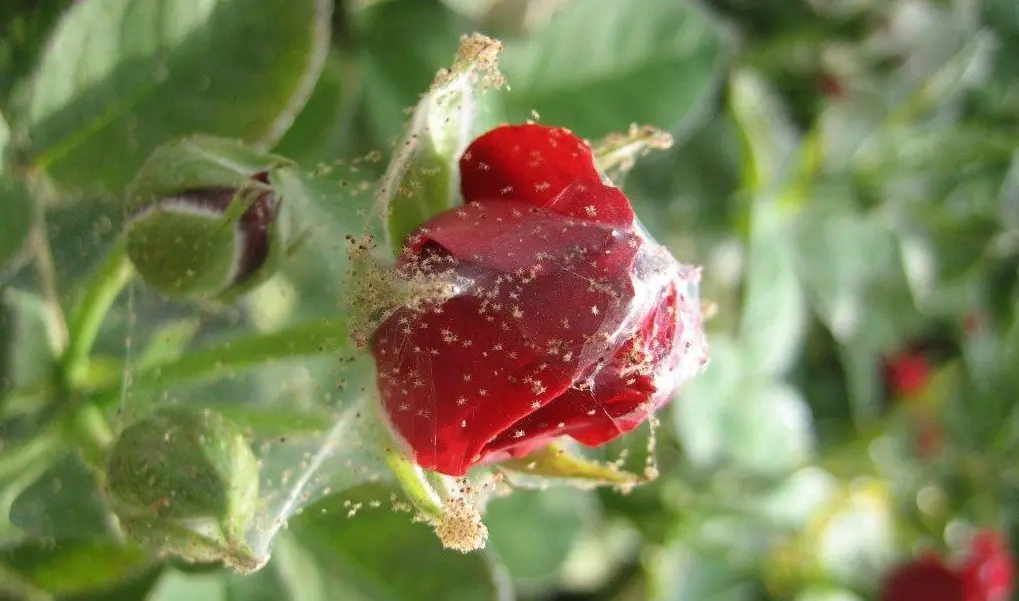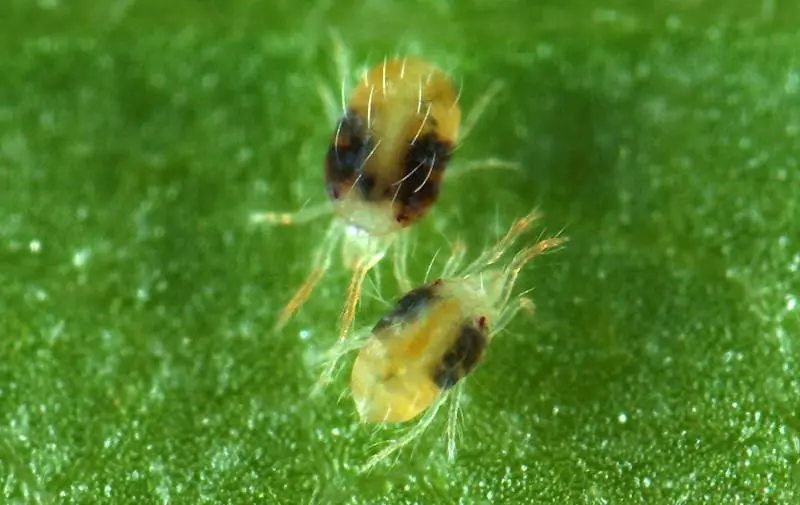Contents
Spider mite on a rose is a fairly common phenomenon, and more often the pest appears not on garden plants, but on a room rose growing in a pot. The mite poses a serious danger to roses, as it seriously damages the leaves and shoots, which leads to the death of the plant. Timely identification and elimination of the pest can save the rose, so the question is: how to get rid of the spider mite? – for flower growers is very relevant. To combat insects, there are various methods and preparations, which will be discussed in the article.
Causes
The spider mite thrives in dry and warm climates. For this reason, it often appears on indoor roses. Often in the room where the plants are kept, the air is dry and warm – and these are ideal conditions for the reproduction of the pest. On garden roses, the insect appears only during the hot period. As a rule, such conditions are created during abnormal summer heat, when day and night air temperatures are almost the same. If the days are warm and the nights are cool and damp, then the likelihood of spreading ticks is not high.
The appearance of mites on indoor roses, by and large, is due to improper or insufficient care. If the plants are rarely watered, not sprayed, then soon various pests appear on them.
Of course, ticks in the house do not form out of nowhere. Most often they are carried by pets or the wind, but sometimes they themselves crawl with the help of their web. On roses growing in the garden, mites get completely unhindered, since their habitat is soil, leaves and tree bark.
Video “Fighting spider mites”
From the video you will learn how to deal with a tick on a rose.
Consequences of infection
The spider mite has a microscopic size (0,3-0,5 mm), so it is almost impossible to see the parasite with the naked eye, and even more so, to notice its appearance on plants in time. Despite its size, it is a serious threat not only to roses, but to any other flowers, as well as garden crops, because by feeding on plant cells, the parasite causes irreparable harm to it.
The tick feeds on the juice of the leaves, which leads to damage to the leaf plate – first small dots appear on it, then the entire leaf is covered with spots. With the destruction of chlorophyll, the intensity of photosynthesis begins to decrease, and, as a result, the plant becomes weak and susceptible to infections. This greatly increases the risk of death of the bush. In addition, ticks themselves are active carriers of various pathogenic microorganisms.
If urgent measures are not taken when a parasite is detected, the plant will slowly die. Spider mites move very quickly from one plant to another, and also multiply intensively – at an air temperature of +30 ° C, the entire breeding cycle is 1 week. The tick lives for a relatively short time – an average of one and a half months, but during this time the female can lay several hundred eggs, from which new pests will appear, and they, in turn, will produce as many more parasites. It is impossible to stop this process without the use of special preparations, so the treatment of flowers must be started before the parasites have spread to the entire bush.
It is also important that the affected plant has a very unattractive aesthetic appearance. The upper part of the leaf plate acquires a marble color (white or gray dots of different sizes appear). On the lower part, you can find live ticks of different ages, a light cobweb, as well as a thin light coating – traces of the vital activity of parasites. In advanced cases, cobwebs and clusters of insect colonies in the form of a green moving mass are clearly visible on the leaves.
Methods of struggle
It is worth clarifying that it is difficult to deal with a tick, since all means act on living individuals, but there are still eggs, from which new pests regularly appear. It has been noted that at normal room temperature +24-25°C, generations change after 2-3 weeks, which means that during this time it is necessary to periodically treat the plant, and do this until complete victory. If at least a few living individuals remain, then in just a couple of weeks they will multiply again and spread to the entire bush.
There are two ways to treat roses from a tick: chemical preparations and folk remedies. Preparations for spider mites on a rose are very effective, but do not forget that they have a toxic effect not only on pests, but also on the plant itself. Therefore, insecticides are recommended to be used only in advanced cases, when more gentle methods do not work.
To combat the tick, drugs are recommended: Actellik, Fitoverm, Fufanon, Neoron, Aktofit. These products are toxic, so before using them, you must open the window, take care of rubber gloves and a respirator. Before starting treatment, the plant should be well watered, the leaves and stems should be washed with soapy water (after this procedure, there will be fewer parasites), and only then sprayed. It is advisable to alternately apply several means to avoid pests getting used to them.
Among folk remedies, there are many recipes that allow you to fight a tick, but, unfortunately, they are effective only at the initial stage of infection:
Folk remedies are safe for plants and the environment, but their effectiveness compared to chemical preparations is much lower. If there are a lot of insects on the bush, you should not waste precious time – it is better to immediately start treatment with more serious means, strictly adhering to the recommendations in the instructions.
Prevention
To prevent the appearance of spider mites, it is necessary to regularly and properly care for roses. Since the pest actively breeds in hot and dry conditions, the first step is to ensure high-quality moisture of the soil, air and the plant itself. In hot weather, roses are recommended to be sprayed with settled water at room temperature. It is very important at the same time to ensure that water does not linger on the leaves for a long time, since prolonged humidity contributes to the development of fungal diseases and putrefactive processes. You should also regularly remove dry leaves and faded buds – the tick can linger or settle in these parts of the plant, and gradually infect the entire bush.

Video “Consequences of the spider mite”
From the video you will learn what happens to roses if you do not fight the tick.









